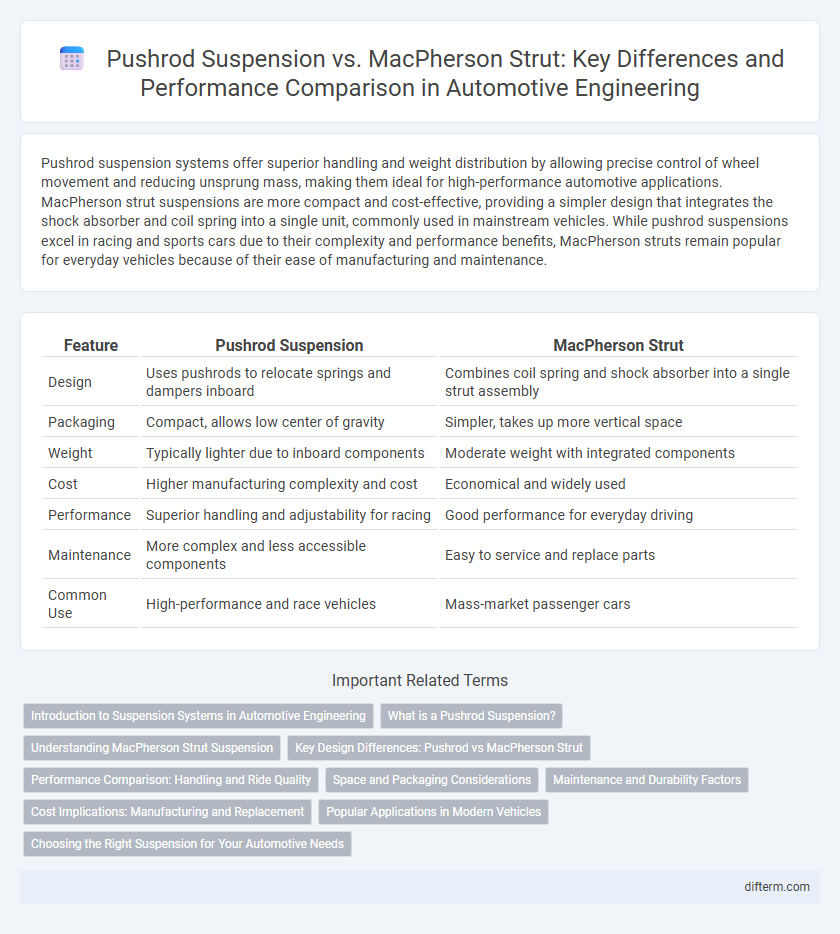Pushrod suspension systems offer superior handling and weight distribution by allowing precise control of wheel movement and reducing unsprung mass, making them ideal for high-performance automotive applications. MacPherson strut suspensions are more compact and cost-effective, providing a simpler design that integrates the shock absorber and coil spring into a single unit, commonly used in mainstream vehicles. While pushrod suspensions excel in racing and sports cars due to their complexity and performance benefits, MacPherson struts remain popular for everyday vehicles because of their ease of manufacturing and maintenance.
Table of Comparison
| Feature | Pushrod Suspension | MacPherson Strut |
|---|---|---|
| Design | Uses pushrods to relocate springs and dampers inboard | Combines coil spring and shock absorber into a single strut assembly |
| Packaging | Compact, allows low center of gravity | Simpler, takes up more vertical space |
| Weight | Typically lighter due to inboard components | Moderate weight with integrated components |
| Cost | Higher manufacturing complexity and cost | Economical and widely used |
| Performance | Superior handling and adjustability for racing | Good performance for everyday driving |
| Maintenance | More complex and less accessible components | Easy to service and replace parts |
| Common Use | High-performance and race vehicles | Mass-market passenger cars |
Introduction to Suspension Systems in Automotive Engineering
Pushrod suspension systems offer enhanced handling and reduced unsprung weight by relocating the spring and damper inboard, making them prevalent in high-performance racing vehicles. MacPherson strut suspensions provide a compact, cost-effective solution with a combined shock absorber and coil spring, widely used in mass-produced passenger cars for their simplicity and space-saving design. Both suspension types influence vehicle dynamics, ride comfort, and manufacturing costs, and their selection depends on application-specific requirements such as performance, packaging constraints, and maintenance considerations.
What is a Pushrod Suspension?
Pushrod suspension is a high-performance automotive suspension system that uses a pushrod lever to transfer wheel movement to inboard-mounted springs and dampers, reducing unsprung weight and improving handling precision. Commonly found in racing and sports cars, it allows for better aerodynamic packaging by relocating heavy suspension components away from the wheel hubs. This design enhances suspension responsiveness and stability during high-speed cornering compared to traditional setups like the MacPherson strut.
Understanding MacPherson Strut Suspension
MacPherson strut suspension combines a shock absorber and coil spring into a single unit, offering compact design and efficient space utilization favored in front-wheel-drive vehicles. Its simplicity reduces weight and manufacturing costs while providing effective handling and ride comfort. Compared to pushrod suspension, MacPherson struts deliver easier maintenance and improved compatibility with mainstream automotive designs.
Key Design Differences: Pushrod vs MacPherson Strut
Pushrod suspension features a horizontally mounted pushrod linking the wheel hub to an inboard-mounted spring and damper, allowing for better packaging and reduced unsprung weight. MacPherson strut combines a shock absorber and coil spring into a single, vertical unit directly attached to the wheel hub and vehicle chassis, prioritizing simplicity and cost-efficiency. Key differences include pushrod's superior handling capabilities and adjustability versus MacPherson strut's compact design and lower manufacturing cost.
Performance Comparison: Handling and Ride Quality
Pushrod suspension systems offer superior handling by reducing unsprung weight and allowing for precise tuning of suspension geometry, resulting in enhanced cornering stability and responsiveness. MacPherson struts provide a simpler, more compact design that prioritizes ride comfort and cost-efficiency but may sacrifice some handling precision due to higher unsprung mass and limited adjustability. In performance-oriented vehicles, pushrod setups deliver sharper feedback and improved dynamic control, while MacPherson struts remain prevalent in passenger cars for balanced ride quality and manufacturing ease.
Space and Packaging Considerations
Pushrod suspension systems offer superior space efficiency by relocating components away from the wheel assembly, allowing for lower unsprung weight and improved aerodynamic packaging. MacPherson strut designs require more vertical space within the wheel well, limiting suspension travel and complicating engine bay layout in compact vehicles. Optimizing space utilization with pushrod setups enables better chassis design and performance in high-performance or racing applications.
Maintenance and Durability Factors
Pushrod suspension systems generally require less frequent maintenance due to their enclosed design and fewer exposed components, which protects critical parts from debris and wear. MacPherson strut setups are simpler and cheaper to repair but often demand more regular inspections and replacements of strut mounts, bearings, and bushings due to their exposure to road conditions. Durability-wise, pushrod suspensions excel in high-performance and racing environments, offering superior longevity under extreme loads, while MacPherson struts are more suited for everyday driving with moderate durability expectations.
Cost Implications: Manufacturing and Replacement
Pushrod suspension systems generally incur higher manufacturing costs due to their complex design and specialized components compared to the more straightforward and widely used MacPherson strut. Replacement expenses for pushrod setups are also elevated because of limited availability of parts and the need for skilled labor during maintenance. In contrast, the MacPherson strut offers more cost-effective production and easier, less expensive replacement options, making it a favored choice for mass-market vehicles prioritizing budget efficiency.
Popular Applications in Modern Vehicles
Pushrod suspension systems are commonly found in high-performance race cars and some supercars due to their superior handling and adjustability. MacPherson strut suspensions dominate the mass-market automotive segment, appearing in a wide range of compact and midsize vehicles because of their cost-efficiency and space-saving design. Popular models featuring MacPherson struts include the Toyota Corolla, Honda Civic, and Ford Focus, while pushrod setups are prevalent in Formula 1 and Le Mans prototypes.
Choosing the Right Suspension for Your Automotive Needs
Pushrod suspension offers superior handling and adjustability, making it ideal for high-performance and racing vehicles seeking precise control and reduced unsprung weight. MacPherson struts provide a compact, cost-effective solution commonly used in mass-market cars, balancing ride comfort and space efficiency. Selecting the right suspension depends on priorities such as performance, budget constraints, and vehicle application, with pushrod suited for track-focused builds and MacPherson struts excelling in everyday driving scenarios.
pushrod suspension vs MacPherson strut Infographic

 difterm.com
difterm.com